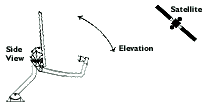| Now that you have your azimuth and elevation coordinates, what do you do
with them?
 First, survey the site to ensure an unobstructed view in the direction of the satellite.
To receive DBS broadcast signals, your DBS dish needs to be positioned correctly. Mount
your DBS dish so that the base fits flush with the mounting surface (level if mounted on a
flat beam or roof, or on an angle to match the pitch of your roofline). When you have
securely mounted your DBS dish, adjust your dish so that the dish mast is plumb, that is,
exactly perpendicular to level - this is best achieved
using a carpenter's level. With
your dish now mounted and properly set, you are now ready to aim your dish toward the
satellites.
First, survey the site to ensure an unobstructed view in the direction of the satellite.
To receive DBS broadcast signals, your DBS dish needs to be positioned correctly. Mount
your DBS dish so that the base fits flush with the mounting surface (level if mounted on a
flat beam or roof, or on an angle to match the pitch of your roofline). When you have
securely mounted your DBS dish, adjust your dish so that the dish mast is plumb, that is,
exactly perpendicular to level - this is best achieved
using a carpenter's level. With
your dish now mounted and properly set, you are now ready to aim your dish toward the
satellites.
To set the dish to point up to the satellites, you’ll first need to set the
elevation. Then you’ll point the dish in the proper left-to-right position, to set
the azimuth. You’ll need to refer to the installation manual for your DBS system for
detailed instructions, but here’s the short course.
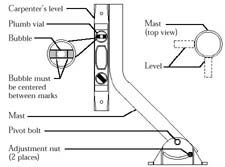 1.
Select a flat and secure site to install the antenna base
plate. 1.
Select a flat and secure site to install the antenna base
plate.
2.
Place the base plate so the outside holes are positioned
over the brick surfaces. Do not drill into the mortar
between the bricks.
3.
Using a carpenters level, plumb the antenna mast in at
least two different locations on the side of the mast, as
shown in diagram at right. These two measurements should
be at right angles to each other. If the mast is plumb
(aligned vertically with the bubble level), go to step 5.
Otherwise, loosen the adjustment nuts.
4.
Rotate the mast until it is plumb with the level, then use
the torque wrench to tighten the adjustment nuts to 15
ft-lbs. If you are still unable to align the mast with the
level, try using wooden shims. If they do not correct the
problem, you will need to find another site to install the
antenna.
Be sure to follow the safety precautions and
warnings contained in the installation and operation manuals for your DBS system.
- Make sure where ever you mount the mast (see illustrations
below) that it's plumb with the ground.

- Realize that from the dish to the receiver your wire must not
have any splitters in the way. It should be one solid line
unless you're putting a grounding block on the side of your house.
- A clear line of sight is a must. These are reflective dishes, so
it's easier to get over objects than under, for example, tree
leaves. Once setup is complete and you are ready to find the
Satellite, follow these easy steps.
a. Pull up the signal meter screen through the main menu on
your receiver. You'll need this to find the setting for the dish and
to see when you hit the Satellite.
b. Begin by pointing your dish south.
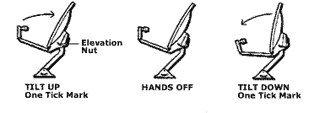
c. Setting the Elevation (UP),
(DOWN)
You can set the proper elevation after the dish is securely mounted.
First, loosen the nuts securing the two elevation bolts so that the dish easily moves up
and down. Line up the elevation indicator with the tick mark corresponding to your
elevation number. Then tighten the bolts. Be sure to stop 5
to 10 seconds between each movement so that the receiver has time to
catch the signal.
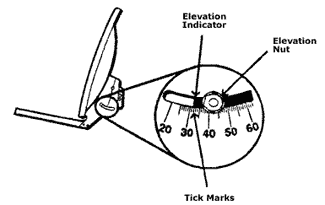 d.
If you hit any number besides 0 on the signal meter screen of the
TV, you are on the Satellite and you just need to fine tune the
signal with small movements up and down, left and right, or both. If
you fail to find the Satellite on the first pass, move the setting
on the dish up to a four-point variance on the settings. Example: If
it said 42 on the zip code screen, you could go from 40-44 on the
settings d.
If you hit any number besides 0 on the signal meter screen of the
TV, you are on the Satellite and you just need to fine tune the
signal with small movements up and down, left and right, or both. If
you fail to find the Satellite on the first pass, move the setting
on the dish up to a four-point variance on the settings. Example: If
it said 42 on the zip code screen, you could go from 40-44 on the
settings
.
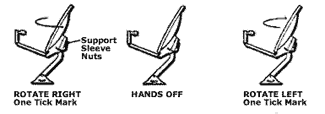 e. Setting the Azimuth (LEFT),
(RIGHT) e. Setting the Azimuth (LEFT),
(RIGHT)
Loosen the azimuth nuts on the LNB arm enough that the dish can be
turned smoothly with little pressure. Set the azimuth by moving the dish left and right.
Point the dish in the general direction of the satellite, in the southern hemisphere. By
using a compass you can better pinpoint the direction with your azimuth number to
correspond with the degrees on your compass. Now that you have
moved the dish down or up a mark, go back from 2 O'clock to 1
O'clock moving again only 1/4 movements and stopping in between
moves.
f. Repeat steps C, E, and F until you find the Satellite.
- You must be above 50 on the signal meter to acquire steady
programming.
- Acquiring the Signal
Now your dish will be in position to lock in on the satellite signal.
You’ll need to 1) have your DBS receiver connected to your television, with both
turned on, and 2) have your antenna to receiver cables connected, and 3) be viewing your
Setup Antenna/Signal Strength display from your DBS on-screen menu to measure the signal
strength accurately. (The DSS system manual tells you how to find this display.)Ask a helper to watch the Signal Strength screen for indications
you are receiving the signal. Stand behind the dish, and holding its outer edges, slowly
turn it a little to the right to adjust the azimuth. Pause a few seconds, giving the
receiver enough time to lock in on the satellite signal. Continue turning the dish in this
way until you have acquired the signal or until you have rotated the dish approximately 15
degrees from the starting point.
If you haven’t detected a signal yet, return to the starting
point and move the dish to the left again. If you don’t acquire the signal after
rotating the dish approximately 15 degrees to either side of the calculated azimuth angle,
loosen the elevation bolts and tilt the dish upward so the elevation indicator moves
halfway from the current tick mark to the next mark. Then tighten the elevation bolts.
If necessary, continue changing the elevation in half-tick-mark
increments until you receive the signal. After tilting the dish upwards three tick marks
beyond the original tick mark, return it to the original tick mark and then tilt it down a
half tick mark. Keep repeating this until you receive the signal.
You will never see 100, but high 70's to low 80's will
give you enough variance for wind, snow and rain fade.
Fine Tuning
Now that you have received the satellite signal, it is important to fine tune the dish
pointing to make sure you have the maximum possible signal strength. Maximizing the signal
is important, in that, it reduces "rain fade" during inclement weather. Loosen
the elevation bolts, then gently continue turning the dish a little in the same direction
you were turning it when you began to receive the satellite signal. Pause for a few
seconds each time after moving the dish. Turn the dish in this way until the signal
strength reaches its highest reading and then begins to fall. Then slowly turn the dish
the opposite way until you again receive the highest reading on the Signal Strength
screen. Important: The Signal Strength reading does not need to be "100."
Lock in on the highest possible signal. Tighten the azimuth bolts.
Loosen the elevation bolts. Slowly tilt the dish up and down to
improve the Signal Strength reading. When you are satisfied that you have the strongest
signal, tighten the elevation bolts.
- Lock down the system once the highest signal has been obtained
and call in your programming with Pending
Account number that was provided by Orbit by the 800 numbers
provided by Orbit.
|
Congratulations!
You did it! |






